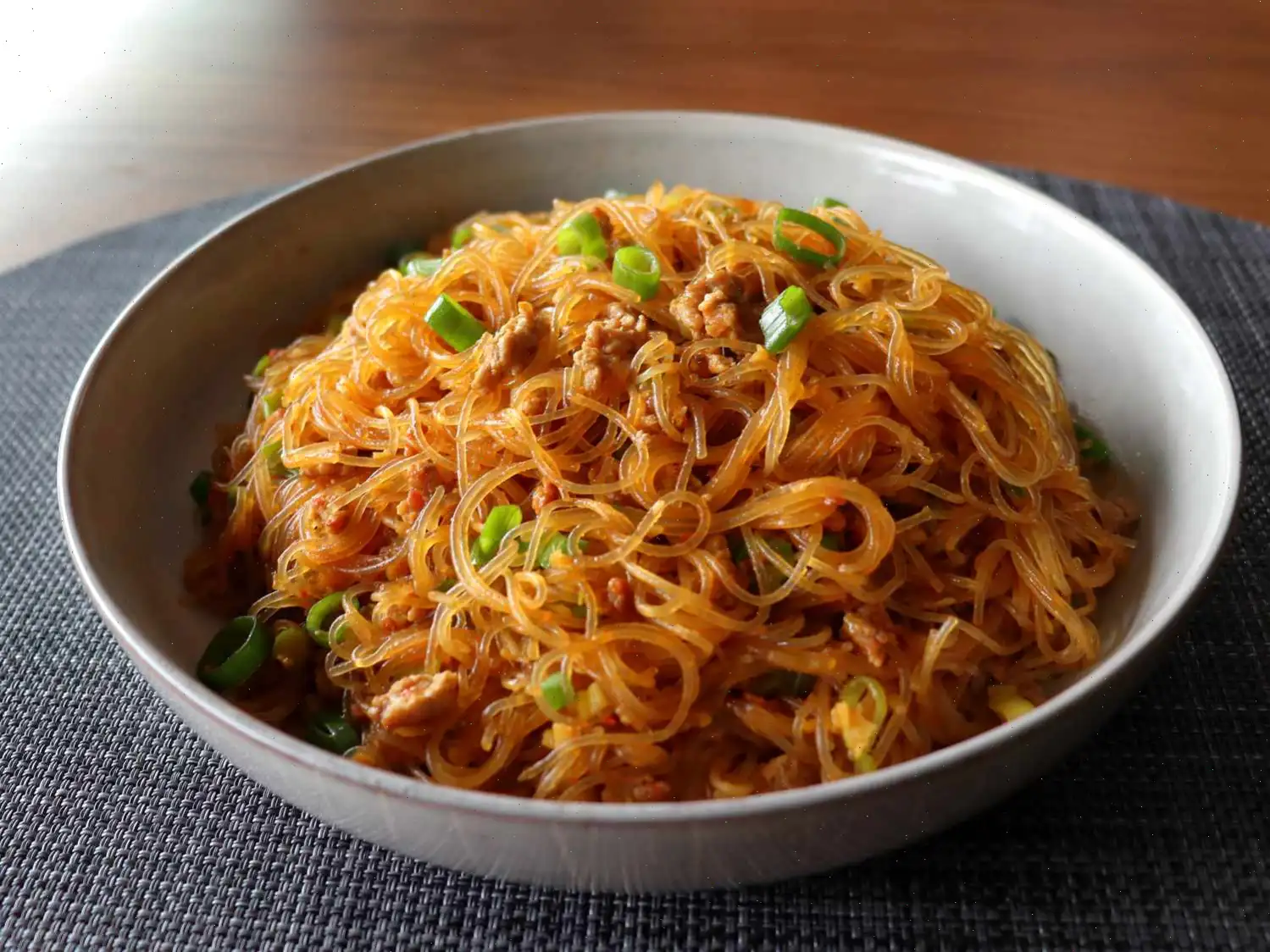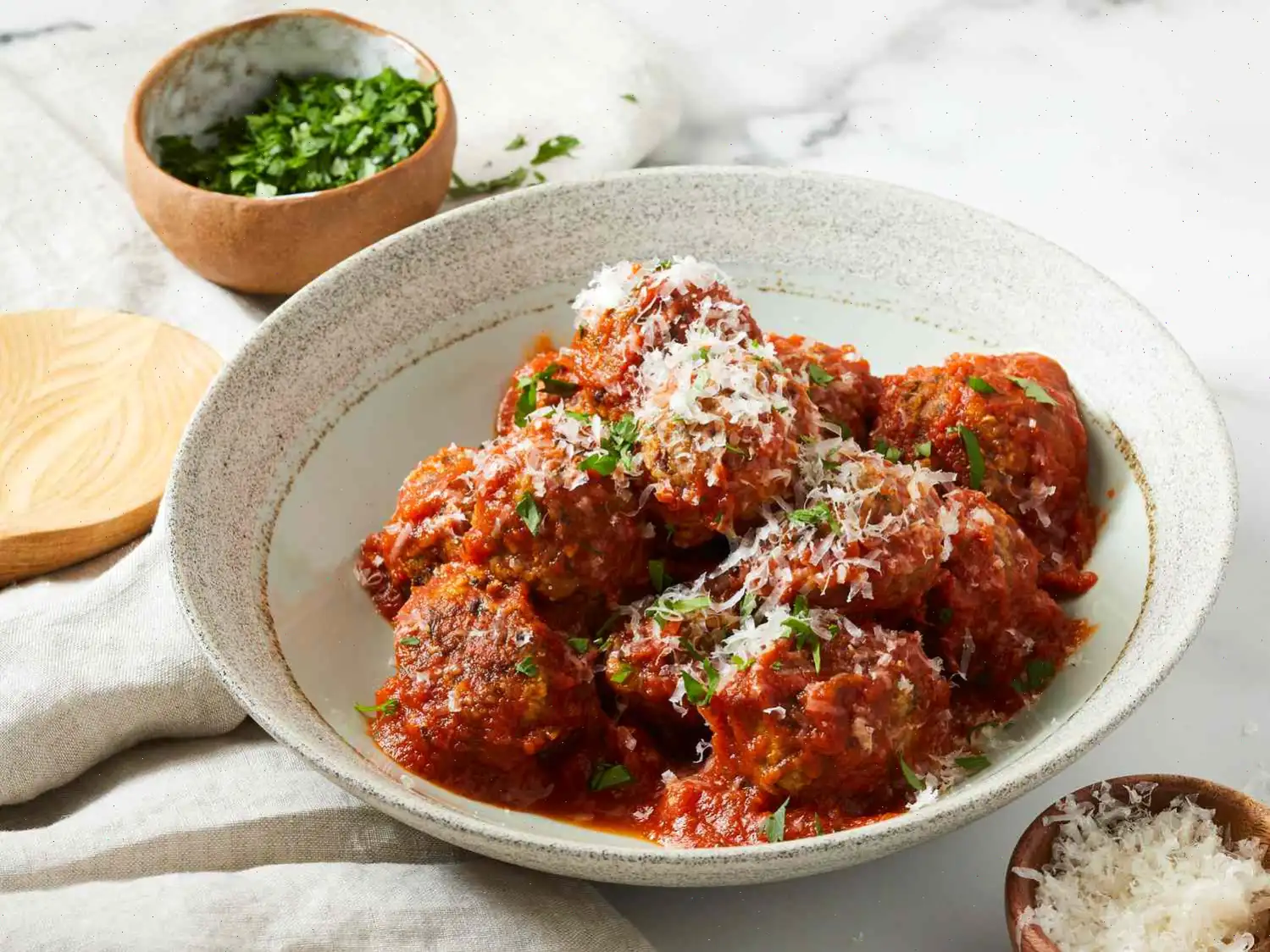
Ants Climbing a Tree Glass Noodles Recipe
Ingredients
- 4 ounces mung bean glass noodles (mung bean vermicelli)
- 2 tablespoons vegetable oil
- 6 ounces ground pork
- 3 garlic cloves, finely minced
- 1 tablespoon finely minced ginger
- 2 tablespoons Chinese spicy fermented bean sauce
- 1/4 teaspoon ground Sichuan pepper (optional)
- 1 teaspoon white sugar
- 2 teaspoons soy sauce
- 2 cups chicken stock
- 1/3 cup sliced green onions, plus more for garnish, or to taste
Directions
- Start by placing the dry glass noodles in a large bowl. Cover them with cold water and gently separate the strands using your fingers. Make sure the noodles are fully submerged. Let them soak for 10 minutes. Once done, drain the noodles well and set them aside.
- While the noodles are soaking, heat the vegetable oil in a skillet over medium-high heat. Add the ground pork and cook for 3-4 minutes, breaking the meat into small crumbles with a spatula. Continue cooking until the pork begins to brown, about 1-2 more minutes.
- Add the minced garlic, ginger, and Chinese spicy fermented bean sauce to the skillet. Stir everything together and cook for another minute, letting the flavors meld.
- Stir in the Sichuan pepper and white sugar, and cook for an additional 30 seconds to blend the flavors.
- Pour in the soy sauce and chicken stock, then raise the heat to high. Bring the sauce to a boil.
- Add the drained glass noodles and sliced green onions to the skillet. Toss the noodles using tongs, ensuring they are well coated with the sauce. Cook for 2-3 minutes until the noodles are soft but still slightly chewy.
- Remove the skillet from the heat. The noodles will continue to soak up the sauce as they sit.
- Transfer the noodles to a serving bowl and garnish with additional sliced green onions. Serve immediately and enjoy!
Chef's Note: Do not substitute rice vermicelli for mung bean glass noodles. Rice vermicelli does not have the same texture or absorbency as mung bean-based noodles, which should be your go-to in this recipe.
Nutrition Facts (per serving):
| Calories | 37g Fat | 82g Carbs | 49g Protein |
|---|---|---|---|
| 860 | 47% Daily Value | 30% Daily Value | 99% Daily Value |
Nutrition Breakdown:
- Total Fat: 37g (47% DV)
- Saturated Fat: 10g (49% DV)
- Cholesterol: 88mg (29% DV)
- Sodium: 1107mg (48% DV)
- Total Carbohydrates: 82g (30% DV)
- Dietary Fiber: 17g (61% DV)
- Total Sugars: 13g
- Protein: 49g (99% DV)
- Vitamin C: 9mg (10% DV)
- Calcium: 133mg (10% DV)
- Iron: 7mg (39% DV)
- Potassium: 1591mg (34% DV)
* Percent Daily Values are based on a 2,000-calorie diet. Your daily values may be higher or lower depending on your calorie needs.
The Story Behind Ants Climbing a Tree
Ants Climbing a Tree, or Mo Xio Sh in Chinese, is a classic dish originating from Sichuan Province, China. Its intriguing name comes from the visual effect of ground pork clinging to translucent glass noodles, resembling ants climbing on branches. The dish has been part of Sichuan cuisine for centuries, reflecting the region's love for bold flavors and textured dishes. Traditionally, it was a home-cooked meal prepared during family gatherings, and over time it became popular in restaurants and street food stalls.
Regional Characteristics
While its roots are in Sichuan, the dish has spread throughout China with subtle variations. In Sichuan, it is typically spicier, using Sichuan peppercorns and fermented bean paste, giving a numbing and savory flavor known as ml. In other regions, chefs may reduce the heat, add more vegetables, or substitute pork with chicken or beef. Despite these variations, the essential combination of glass noodles and seasoned ground meat remains unchanged, maintaining its identity across the country.
Differences from Similar Dishes
Ants Climbing a Tree is often compared to other noodle dishes such as chow mein or lo mein. Unlike those stir-fried wheat noodles, this dish uses glass noodles made from mung beans, which gives a unique, slightly chewy texture that absorbs flavors differently. The hallmark of Ants Climbing a Tree is the small crumbles of meat clinging to the noodles, a feature not found in typical stir-fried noodle dishes. The combination of spiciness, aromatic ginger and garlic, and the subtle sweetness of sugar sets it apart.
Where Its Usually Served
This dish is versatile in its serving context. In China, it is found in casual eateries, high-end Sichuan restaurants, and during family meals. It is often served as a main dish, accompanied by simple sides such as steamed greens or pickled vegetables. Internationally, it has become a popular dish in Chinese restaurants, particularly those specializing in Sichuan cuisine, and is celebrated for its balance of heat, savoriness, and texture.
Interesting Facts
- The name Ants Climbing a Tree is purely visual; no ants are involved.
- Glass noodles, the main ingredient, are naturally gluten-free, making this dish suitable for those avoiding wheat.
- Traditional Sichuan versions use fermented bean paste, which can vary greatly in saltiness and heat.
- Despite being a spicy dish, the flavor is layeredthere is sweetness, umami, and a subtle numbing sensation from the Sichuan pepper.
- Modern adaptations often include vegetables such as bell peppers or carrots to add color and nutrition, while maintaining the dish's signature texture.
You can listen to this recipe in AI audio format. Simply click the play button below to listen to the content in a format that suits you best. It’s a great way to absorb information on the go!
FAQ about Ants Climbing a Tree Glass Noodles Recipe
Comments
Kevin Mitchell
12/22/2023 07:03:53 PM
Review update: In response to a previous inquiry, I was unable to locate spicy bean sauce, so I substituted with gochujang (my Chinese mother-in-law might cringe at this). Surprisingly, the dish turned out to be absolutely fantastic. My husband devoured his portion and eagerly eyed mine until it vanished as well. The only downside is that it truly serves just two. 😊 Kudos to Chef John for this outstanding recipe.
Gary Thompson
04/10/2025 06:06:09 PM
Despite using ground chicken, this has become my new go-to meal. It turned out to be a memorable dish that my family devoured, quickly becoming a staple in our meal rotation. Treat yourself and try this recipe - you won't be disappointed!
Edward Davis
07/28/2024 08:06:38 PM
Tasty and quick to make in just 20 minutes. Please be aware that the nutritional information provided is for the whole recipe, not per serving. If you have a hearty appetite, consider doubling the ingredients. If you happen to have leftover bean paste, don't fret - it can be used in a stir fry and will taste fantastic.
Ashley Jones
07/21/2023 06:05:49 PM
I have made this recipe twice already, and it is both simple to follow and absolutely delicious.








